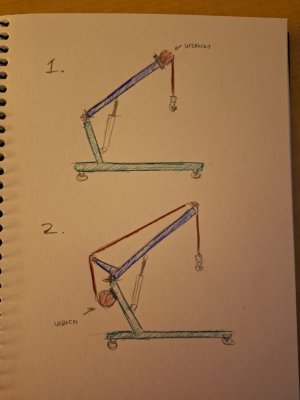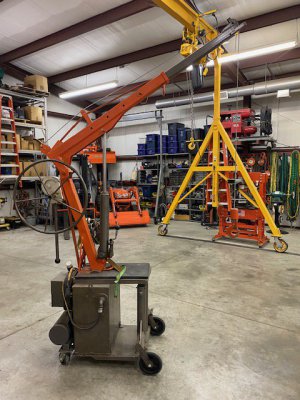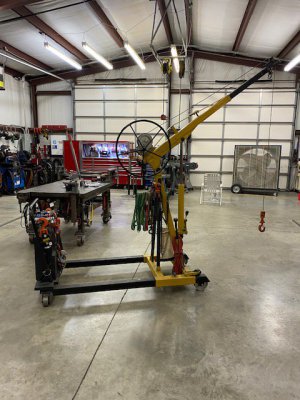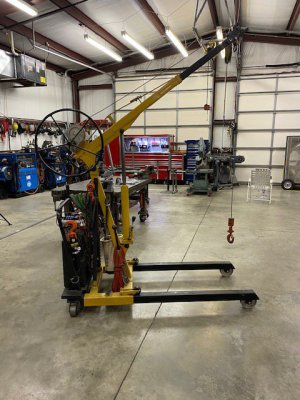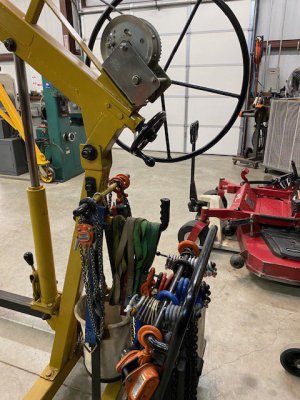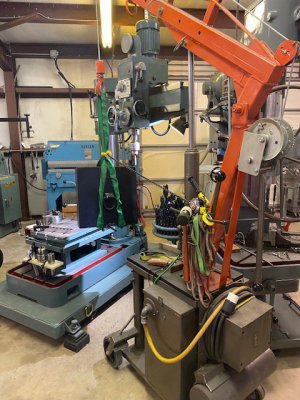I will be purchasing the 2T HF shop crane to move a new mill and lathe to their stands and have atleast a couple modifications I want to make to it first: upgraded castors and some kind of winch.
After a couple image searches it seems everyone is mounting their winch of choice somewhere on the boom. I was brainstorming next to the Manitowac friction crane on site today and thought maybe there would be a benefit in mimicking its winch/pulley design.
I'm no engineer, but my gut as an experienced rigger tells me the winch/pulley arrangement in the #2 sketch might be creating some forces that could help the boom resist collapsing. The first sketch isn't plan B, it just illustrates what I imagine is on the other end of the spectrum.
Tell me what you think. Terrible idea, pointless, or am I genius?
And in case you're wondering I will be using a hand crank boat winch I have in my junk pile.
Don't go modifying like things like cranes, even small ones. There's so many forces that we don't fully understand, material stress calculations, dynamic forces to estimate, welds have to be perfect, new bolt holes make stress risers, load ratings to calculate for the new stuff, you're gonna get us all killed... When the folks at Harbor Freight designed these things.... Oh wait. Never mind. Carry on.

Don't sweat what you saw on the Manatowok crane. The lifting cable(s) probably didn't go over the back of that anyway. The extra framework back there is more about keeping the boom raised properly. The lifting cables "may" go over the back in some models, but it's incidental. That aspect is not about the lifting cables. It's sometimes "involved" in that, but lifting cables are definitely not a reason for that.
"Everybody" is putting the winch on the boom? No. Most of the eight quadrillion (or however many) people have bought engine cranes, since their invention, are happy to use them just as they are.
A few folks indeed do modify theirs to have a winch. The same winch boom (essentially, same factories using common parts) is installed on a different base, meant to be mounted on trailers or pickup trucks. Those can be factory equipped with winches if you get a fancy one. In that case, the winch is not because the bottle jack doesn't work, it's because it allows you to set something down nearer or farther from the base than where you picked it up. The engine crane WILL bring the hook closer to the rear of it, and you WILL be using every inch of it's lift by the time you're done. You will fight with that issue (And probably win... It's just a geometry puzzle that's been solved a lot of times by a lot of people). But the winch will not help with that. The bottle jack that raises it is just not that hard to run. And it's not slow like a bottle car jack, they move along a LOT faster than that. Not lightning fast, but you're not gonna need to pack a lunch I do use them at work (for just about everything), and have never had the need. I do modify the hook. For the task you have at hand, you're going to need at least two people anyhow. You'll probably be more than fine by just shortening the chain.
Here's a mod I'd do- Take the hook/chain out, hold the chain in two fingers by the first proper link of chain. The one that hooks to the big ring. Let the rest of the chain fall down. Take that first link, stuff it back up in the slot and put the bolt through it. Bam. Five inches more lift height.
Here's another mod I'd do. If you're going to use this more than twice a year, find a eight inch piece of half inch black pipe, ten inch if you buy a nipple, so you can cut the threads off, (or anything about that diameter, it doesn't even need to be stout. Grind a slot in it so you can catch the "T" bolt that lowers/locks the jack(ram). Bam. Overdrive transmission. Seriously Do that.
Here's a third mod I'd do. Take a piece of one and a half or two inch PVC pipe that's six inches shorter than the original handle. Whatever it'll fit in. Zip tie it to one of the angled support slats that hold the back of the hoist upright. If you're lucky it'll be able to sit on top of the "rear wheel beam", or if not, stick a cap on it. Store the factory handle in there so you won't use it much once you've made the other one.. The short one doesn't protrude so much, and so can live in the jack. Bam. Onboard tool storage...
Ten minutes of work, twenty bucks if you bought the most expensive stuff you could find, (could be almost zero if you keep stuff kicking around) and you can run your hoist more efficiently and with less effort than any of the "modded" ones that the YouTube algorythm feels are watchworthy.


